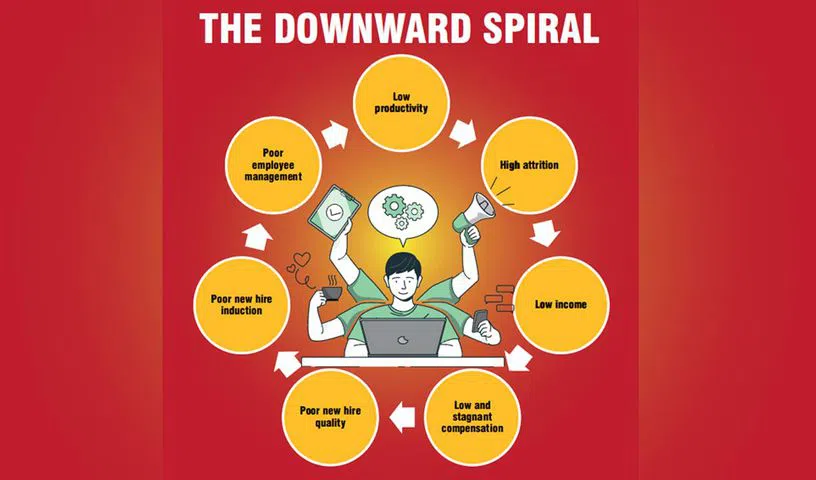To create a mediocre nation is very easy. create a mediocre workforce and a mediocre enterprise. We are doing this successfully in India today. How can a mediocre nation aspire to be a world economic power?
When a child is born in India, 25 million-plus are born every year, parents start worrying about finding the right school. When the child reaches high school, worry increases about passing Class 10 with high marks – 13 million children passed Class 10 in 2023. When the child reaches Class 12, fear of tough competitive exams like JEE kicks in and parents spend their hard-earned money on coaching. When the child enters college, worry continues about staying and passing the course. When the child enters the final year of college, worry reaches the peak — will the child get a job in the right company with a decent salary?
Over 8 million graduates pass out every year in India while it is over 11 million for China. The child gets a job at campus placement and it is always a frontline job in sales, customer service or operations. And then the rubber hits the road.
Mediocre Workforce
Within six months, the new entrant into frontline, after 16-plus years of study and anticipation, realises that s/he has to quit or will be asked to quit because of poor performance. The infant attrition (attrition in the first six months) is more than 60% in the private sector. This is traumatic for any young person and also for the shocked parent. The career dream goes for a toss and the rolling-stone career trajectory starts. This is how we create a nation of mediocre and frustrated youth workforce.
Mediocre Enterprise
When a new enterprise starts, the entrepreneur starts worrying about survival — will we stay relevant to our customers? As the enterprise grows, the first set of people he hires is the frontline in sales, who face customers. And as the enterprise grows, the frontline grows to 70% of all the employees. The harsh reality of the frontline workforce of high attrition and low productivity now hits the enterprise — 11 million of the workforce in the organised salaried class in every sector are in the frontline. “Hire and fire” begins and the customer experience and business continuity go for a toss. The enterprise goes into a downward spiral. This is how we create a nation of mediocre enterprises.
Fault Lines
We have designed our frontline jobs, especially in the private sector, for failure. Bulk of the job creation is in the private sector. Wrong hiring, wrong induction, inadequate hand-holding on the job for new entrants, wrong targets, wrong incentives, absence of timely re-skilling — all these result in low or stagnant salaries and induction of lower and lower quality workforce. They work together to create a downward spiral (see figure) of low wages and low productivity in the frontline.
Together with a mediocre workforce and a mediocre enterprise, and a downward spiral of productivity, we have successfully created a mediocre nation with high aspirations.
How big is this low productivity problem?
• Annualised attrition in the first 6 months is between 60% and 80%
• 80% of the new joinees from campus start looking for a job after 3 months in service
• 21% were zero performers in residency month. In the same month, 26% were 200% or more performance achievers
• After 12 months, top 10% were performing 10X more compared with bottom 10%
• Cost of under-performance is staggering. Company can achieve 33% more sales with the same sales team. Or one-third of the HR budget can be cut and it can still achieve the current sales.
The Way Out
We need to create a positive spiral of higher wages and better quality workforce induction and this requires higher productivity in the frontline jobs. Productivity does happen only by designing and engineering the frontline work environment for the frontline to win on-the-job — their first job. This is the only way we can meet the aspirations of our youth and put our enterprises on a positive spiral, out of mediocrity.
We must recognise that this problem has not been solved despite the best efforts of over 1,00,000 large and medium employers. Why? There are many reasons. First, the employers were stuck in past with old concepts. Second, employers were experimenting with the same piecemeal solutions. Einstein once said, “insanity is doing the same thing and expecting different results”. Lastly, they were not listening to their own performance data which told a very different but very interesting story — that in most frontline cohorts, two out of five were poor performers but one in six were high performers in the same role cohort, at the same time. Nobody asked two simple questions: what are these high performers doing differently? why can’t we replicate it?
A Center of Excellence of Frontline Workforce Productivity (CoE FWP) was started in 2021 to research these problems. The CoE found that secret of success of high performers: they prioritised their daily routine to focus on a few critical jobs in the role and executed them very differently. They discovered the best practices in these critical tasks and repeated it. I call this ‘critical task mastery’.
Skill vs Role Mastery
Our education system is designed mostly to impart knowledge. Many training institutions claim to impart skills to obtain skill mastery. Why? Because the role in which the person will work is not known at this time. This must change. We must ensure that the college students pass out with role mastery. How do we do this? First, in the final year, students are given job counselling and each student is asked to choose a few job roles. Then the placement season begins and the student gets selected. Then in the last three months, the student will undergo role mastery courses offered by the employer, on the campus, before entering the job.
This is not enough. The employer must set up a role induction programme on the critical tasks and also create on-the-job learning environment to master the critical tasks in the role every day. Only this will ensure that the new employee reaches a threshold level of productivity on-the-job. Then both the employer and the employee are pulled out of mediocrity. And the nation moves out of mediocrity.
In short, employers must take the responsibility of making every new entrant win in the first job by architecting and engineering the frontline HR policies for success.


